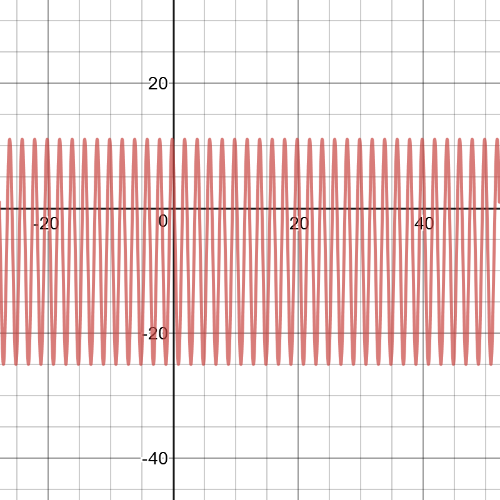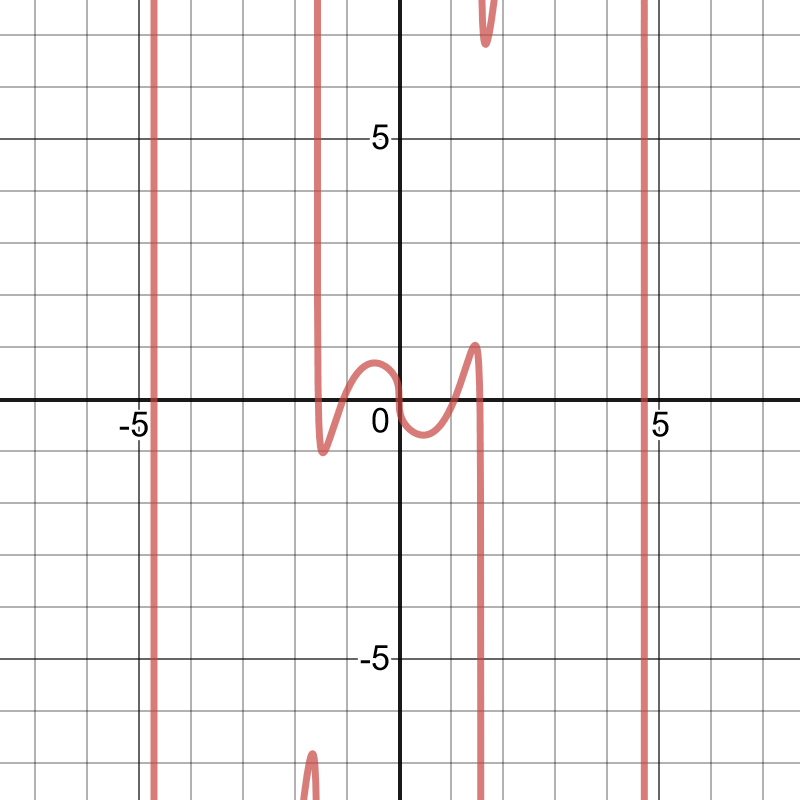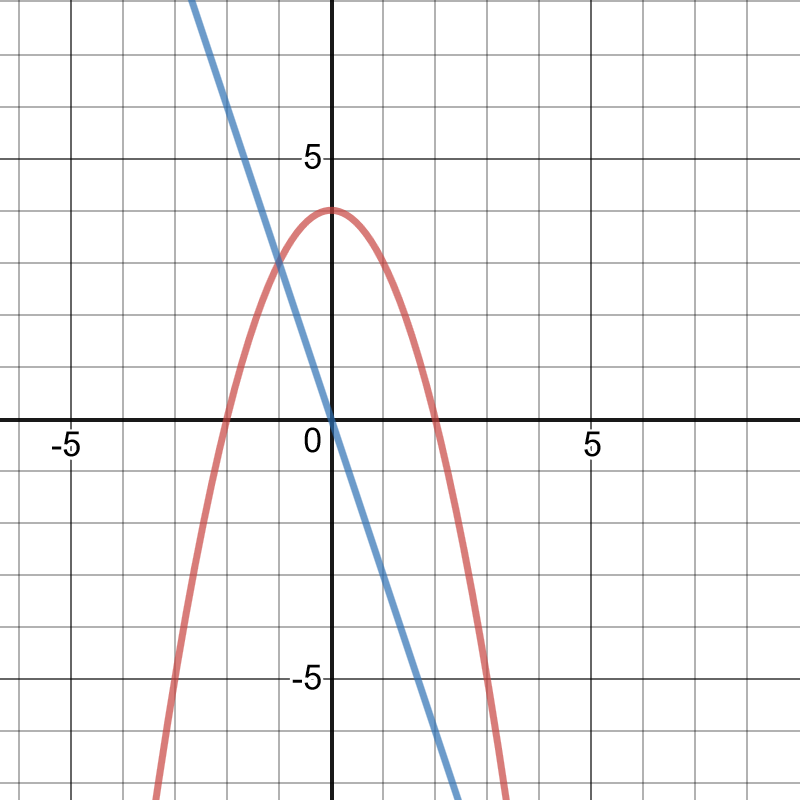
All Solutions
Page 580: Cumulative Review
$sin dfrac{2pi}{5}=cos(dfrac{2pi}{5}-dfrac{pi}{2})=cos(dfrac{4pi}{10}-dfrac{5pi}{10})=cos(-dfrac{pi}{10})$
Since $cos theta=cos(2pi-theta)$, we have:
$cos(-dfrac{pi}{10})=cos(2pi-(-dfrac{pi}{10}))=cos(2pi+dfrac{pi}{10})$.
Since the period of the cosine function is $2pi$, we have that:
$cos(2pi+dfrac{pi}{10})=cos dfrac{pi}{10}$.
Therefore, $textbf{answer (a) is correct}$.
Also, since $cos(pi-theta)=-cos theta$, we have:
$cos dfrac{pi}{10}=-cos(pi-dfrac{pi}{10})=-cos(dfrac{10pi}{10}-dfrac{pi}{10})=-cos dfrac{9pi}{10}$.
Therefore, $textbf{answer (c) is correct}$.
Also, since $sin(pi-theta)=sin theta$, we have:
$sin dfrac{2pi}{5}=sin(pi-dfrac{2pi}{5})=sin(dfrac{5pi}{5}-dfrac{2pi}{5})=sin dfrac{3pi}{5}$.
Therefore, $textbf{answer (b) is correct.}$
Since answers (a), (b) and (c) are all correct, $textbf{the correct answer is $(d)$}$.
$cos dfrac{pi}{12}=cos(dfrac{4 pi}{12}-dfrac{3 pi}{12})=cos(dfrac{pi}{3}-dfrac{pi}{4})$=
$cos dfrac{pi}{3} cos dfrac{pi}{4}+sin dfrac{pi}{3} sin dfrac{pi}{4}=(dfrac{1}{2})(dfrac{sqrt{2}}{2})+(dfrac{sqrt{3}}{2})(dfrac{sqrt{2}}{2})=dfrac{sqrt{2}}{4}+dfrac{sqrt{6}}{4}=dfrac{sqrt{2}+sqrt{6}}{4}$.
So, $textbf{the answer is}$ (b).
$x^2+12^2=13^2$
$x^2+144=169$
$x^2+144-144=169-144$
$x^2=25$
$x=5$
Since $tan alpha=dfrac{opposite leg}{adjacent leg}$,$tan alpha=dfrac{12}{5}$.In addition, $sin beta=dfrac{8}{17}$, the leg opposite the angle $beta$ in a right triangle has a length of $8$, while the hypotenuse of the right triangle has a length of $17$. For this reason, the other leg of the right triangle can be calculated as follows:
$x^2+8^2=17^2$
$x^2+64=289$
$x^2+64-64=289-64$
$x^2=225$
$$
x=15
$$
Since $tan(a+b)=dfrac{tan a+ tan b}{1-tan a tan b}$,
$tan( alpha+beta)=dfrac{tan alpha+tan beta}{1-tan alpha tan beta}=$
$=dfrac{dfrac{12}{5}+dfrac{8}{15}}{1-(dfrac{12}{5})(dfrac{8}{15})}$
$=dfrac{dfrac{36}{15}+dfrac{8}{15}}{1-dfrac{96}{75}}$
$=dfrac{dfrac{44}{15}}{dfrac{75}{75}-dfrac{96}{75}}$
$=dfrac{dfrac{44}{15}}{-dfrac{21}{75}}$
$=dfrac{44}{15}timesleft( -dfrac{75}{21}right)$
$=-dfrac{3300}{315}$
$=-dfrac{220}{21}$
$textbf{Therefore, the correct answer is $a)$}$
$x^2+3^2=8^2$
$x^2+9=64$
$x^2=55$
$x=sqrt{55}$
Since $tan theta=dfrac{opposite leg}{adjacent leg}$, we have that:
$tan theta=-dfrac{3}{sqrt{55}}=-dfrac{3sqrt{55}}{55}$
Since $tan 2theta=dfrac{2tan theta}{1-tan^2 theta}$, we have:
$tan 2theta=dfrac{2(-dfrac{3sqrt{55}}{55})}{1-(-dfrac{3sqrt{55}}{55})^2}=dfrac{-dfrac{6sqrt{55}}{55}}{dfrac{2530}{3025}}=-dfrac{3sqrt{55}}{23}$.
Therefore, $textbf{the correct answer is (a)}$.
$$
2cdot dfrac{pi}{8}=dfrac{pi}{4},$$
and we know that $cos frac{pi}{4}=frac{sqrt{2}}{2}$, which we can use to compute the cosine function of an angle $frac{pi}{8}$.
The cosine function of a double angle is
$$
cos(2theta)=cos^2theta-sin^2theta.$$
Using the Pythagorean Identity $cos^2theta+sin^2theta=1$ we can substitute $sin^2theta=1-cos^2theta$ in the equation above, and obtain the equation with only the cosine function. Hence, we obtain:
$$
begin{align*}
cos(2theta)&=cos^2theta-(1-cos^2theta)\
&=cos^2theta-1+cos^2theta\
&=2cos^2theta-1.quadquad(1)
end{align*}$$
$$
cos dfrac{pi}{4}=cosleft(2cdotdfrac{pi}{8} right)=2cos^2dfrac{pi}{8}-1.$$
Substituting the value $cos frac{pi}{4}=frac{sqrt{2}}{2}$ in this equation and adding $1$ throughout, we obtain:
$$
begin{align*}
2cos^2dfrac{pi}{8}&=dfrac{sqrt{2}}{2}+1&&text{[Simplify]}\
2cos^2dfrac{pi}{8}&=dfrac{sqrt{2}+2}{2}&&text{[Divide by $2$ throughout]}\
cos^2dfrac{pi}{8}&=dfrac{2+sqrt{2}}{4}&&text{[Find square root on both sides]}\
cosdfrac{pi}{8}&=sqrt{dfrac{2+sqrt{2}}{4}}\
cosdfrac{pi}{8}&=dfrac{sqrt{2+sqrt{2}}}{2}.
end{align*}$$
Hence, the exact value of the given function is given as an answer *(d)*.
$dfrac{2-sec^2(dfrac{1}{2}x)}{sec^2(dfrac{1}{2}x)}=dfrac{2}{sec^2(dfrac{1}{2}x)}-dfrac{sec^2(dfrac{1}{2}x)}{sec^2(dfrac{1}{2}x)}$
$=2 cos^2left(dfrac{1}{2}x right)-1$
Since $cos 2theta=2cos^2theta-1$,
$2cos^2left(dfrac{1}{2}x right)-1= cos 2left(dfrac{1}{2}x right)=cos x$
Therefore,the correct answer is $c)$.
$dfrac{2 tan x}{1+ tan^2 x}=dfrac{2dfrac{sin x}{cos}}{sec^2 x}$
$=2dfrac{sin x}{cos x}times cos^2x$
$=2 sin x cos x$
$=sin 2x$
The identities $1+tan^2x=sec^2x$, $sin 2x=2sin x cos x$, and $tan x=dfrac{sin x}{cos x}$ were all used in the proof.
$textbf{Therefore, the correct answer is d) }$.
$5+7 sin theta= 0$
$5+7 sin theta-5=0-5$
$7 sin theta=-5$
$dfrac{7 sin theta}{7}=-dfrac{5}{7}$
$sin theta=-dfrac{5}{7}$
$-sin^{-1}(sin theta)=sin^{-1}left(-dfrac{5}{7} right)$
$theta=sin^{-1}left(-dfrac{5}{7} right)$
$theta=-0.80$ or $-2.35$
$textbf{Therefore, the correct answer is b)}$.
$18cosleft(pi t+dfrac{pi}{4} right)+23geq30$
$18cosleft(pi t+dfrac{pi}{4} right)+23-30geq30-30$
$18cosleft(pi t +dfrac{pi}{4} right)-7geq 0$
The inequality $18cosleft(pi t +dfrac{pi}{4} right)-7geq0$ can be solved
by graphing the function $h(t)=18cosleft(pi t +dfrac{pi}{4} right)-7$ determining where the graph is at or above the $x-axis$.
The graph is as follows:

$2sin x +1=0$
$2sin x+1-1=0-1$
$2 sin x=-1$
$dfrac{2 sin x}{2}=-dfrac{1}{2}$
$sin x=-dfrac{1}{2}$
The solutions to the equation $sin x=-dfrac{1}{2}$ occur at $x=210^o$ or $330^o$.
If $cos x-1=0,$ $x$ can be solved for as follows:
$cos x-1=0$
$cos x-1+1=0+1$
$cos x=1$
The solutions to the equation $cos x=1$ occur at $x=0^o$ or $360^o$. Therefore, the correct answer is $d)$.
(This is because $cos0=1, cosdfrac{pi}{3}=dfrac{1}{2}, cosdfrac{5pi}{3}=dfrac{1}{2},$ and $cos2pi=1$). For this reason,either $costheta-1=0$ or $costheta-dfrac{1}{2}=0$(or both). If the left sides of these two equations are considert factors of a quadratic equation and multiplied together, the result is as follows:
$(costheta-1)left(costheta-dfrac{1}{2} right)=0$
$cos^2theta-costheta-dfrac{1}{2}costheta+dfrac{1}{2}=0$
$cos^2theta-dfrac{3}{2}costheta+dfrac{1}{2}=0$
If both sides of the equation are multiplied by $2$, the result is as follows:
$(2)left(cos^2theta-dfrac{3}{2}costheta+dfrac{1}{2} right)=(2)(0)$
$2cos^2theta-3costheta+1=0$
Since $2cos^2theta-1=cos2theta$, the equation can be rewritten as follows:
$2cos^2theta-1+1-3 costheta+1=0$
$cos2 theta+1-3costheta+1=0$
$cos2theta-3costheta+2=0$
$textbf{Therefore, the correct answer is a)}$.
Therefore,the exponential form of $y=log_{7}x$ is $x=7^y$, and the correct answer is $b)$.
$a$ is negative, $f(x)$ is reflected in the
$x$-axis. Also, if $0<|k|<1$, a horizontal stretch of factor $left| dfrac{1}
{k}right|$ occurs, and if $f(x)=log_{10}x$ a vertical translation of $c$ units
up occurs. Therefore, if $b=1.0117$ is reflected in the $x$-axis, stretched
horizontally by a factor of $3$, and translated $2$ units up, the resulting
function is $f(x)=-log_{10}left(dfrac{1}{3}x right)+2$, and $textbf{the
correct answer is d)}$.
Therefore, $7^{log_{7}49}=7^2=49$, so $textbf{the correct answer is d).}$
$log_{10}T=1.5log_{10}d-0.45$
$log_{10}T=1.5log_{10}11-0.45$
$log_{10}T=log_{10}11^{1.5}-0.45$
$log_{10}T-log_{10}11^{1.5}=log_{10}11^{1.5}-0.45-log_{10}11^{1.5}$
$log_{10}T-log_{10}11^{1.5}=-0.45$
$log_{10}dfrac{T}{11^{1.5}}=-0.45$
$10^{-0.45}=dfrac{T}{11^{1.5}}$
$10^{-0.45}times 11^{1.5}=dfrac{T}{11^{1.5}}times 11^{1.5}$
$T=10^{-0.45}times 11^{1.5}$
$T=0.3548times 36.4829$
$T=12.9$
Therefore, $textbf{the correct answer is c).}$
$log_{4}x+3=log_{4}1024$
$log_{4}x+3-log_{4}x=log_{4}1024-log_{4}x$
$log_{4}1024-log_{4}x=3$
$log_{4}dfrac{1024}{x}=3$
$4^3=dfrac{1024}{x}$
$64=dfrac{1024}{x}$
$64times x=dfrac{1024}{x}times x$
$64x=1024$
$dfrac{64x}{64}=dfrac{1024}{64}$
$x=16$
$textbf{Therefore, the correct answer is a)}$.
So $g(x)$ is a vertical translation of $f(x)$ $2$ units up, and the correct answer is b).
$$
6400$ can be calculated as follows:
$6400<1600(1+0.01)^n$\
$dfrac{6400}{1600}<dfrac{1600(1+0.01)^n}{1600}$\
$4<(1+0.01)^n$ \
$log_{10}4<log_{10}((1+0.01)^n)$\
$log_{10}4dfrac{log_{10}4}{log_{10}(1+0.01)}$\
$n>dfrac{log_{10}4}{log_{10}1.01}$\
$n>dfrac{0.6021}{0.0043}$\
$n>140$\
Since $n$ represents the number of months it will take for the investment to be worth more than $ $6400$, and since there are $12$ months in a year, the number of years it will take for the investment to be worth more than $ $6400$ is $11$ years and $8$ months. Therefore, the correct answer is $c)$.
$$
$133=10logleft(dfrac{I}{10^{-12}} right)$
$dfrac{133}{10}=dfrac{10logleft(dfrac{I}{10^{-12}} right)}{10}$
$dfrac{133}{10}=logleft(dfrac{I}{10^{-12}} right)$
$10^{dfrac{133}{10}}=dfrac{I}{10^{-12}}$
$10^{13.3}=dfrac{I}{10^{-12}}$
$10^{13.3}times 10 ^{-12}=dfrac{I}{10^{-12}}times 10^{-12}$
$I=10^{1.3}$
$I=20.0$ $W/m^2$
Therefore, $textbf{the correct answer is d)}$.
$log_a(x-3)+log_a(x-2)=log_a(5x-15)$
$log_{a}(x-3)(x-2)=log_{a}(5x-15)$
For this reason, $(x-3)(x-2)=5x-15.$ This equation can be solved as follows:
$(x-3)(x-2)=5x-15$
$x^2-3x-2x+6=5x-15$
$x^2-5x+6=5x-15$
$x^2-5x+6-5x+15=5x-15-5x+15$
$x^2-10x+21=0$
$(x-7)(x-3)=0$
$x=7$ or $x=3$
Since it’s impossible to find the $log$ of $0$, $x=3$ is not a valid answer, because if $3$ is substitued back into the original equation, both sides of the equation would have a term of $log_{a}0$. Therefore, the correct answer is $b)$.
$0.017=(3.9)left(dfrac{1}{2} right)^{dfrac{x}{5730}}$
This equation can be solved as follows:
$0.017=(3.9)left(dfrac{1}{2} right)^{dfrac{x}{5730}}$
$dfrac{0.017}{3.9}=dfrac{(3.9)left(dfrac{1}{2} right)^{dfrac{x}{5730}}}{3.9}$
$0.0044=left(dfrac{1}{2} right)^{dfrac{x}{5730}}$
$log0.0044=logleft( dfrac{1}{2}right)^{dfrac{x}{5730}}$
$log0.0044=dfrac{x}{5730}log dfrac{1}{2}$
$-2.3606=left(dfrac{x}{5730} right)(-0.3010)$
$-2.3606=-0.000 05x$
$dfrac{-2.3606}{-0.00005}=dfrac{-0.00005x}{-0.000 05}$
$x=44 933$
The closest answer is $45000$ years, so the correct answer is a).
$P=(150 000)(1.023)^6$
$P=(150 000)(1.1462)$
$P=171 927$
Since the population in $6$ years will be $171 927$, and since the population is increasing at $2.3$ percent per year, the number of people by which the population will increase in the $7$th year from now will be $(171 927)(0.023)=3954$. The closest answer is $4000$, so $textbf{the correct answer is c)}$.
$(ftimes g)(x)=(ax^2+3)(bx-1)$
$(ftimes g)(x)=abx^3-ax^2+3bx-3$
Since $(ftimes g)(x)$ passes through the point $(-1,-3)$, the function can be rewritten as follows:
$-3=ab(-1)^3-a(-1)^2+3b(-1)-3$
$-3=-ab-a-3b-3$
$-3+3=-ab-a-3b-3+3$
$0=-ab-a-3b$
Also, since $(ftimes g)(x)$ passes through the point $(1,9)$, the function can be rewritten as follows:
$9=ab(1)^3-a(1)^2+3b(1)-3$
$9=ab-a+3b-3$
$9+3=ab-a+3b-3+3$
$12=ab-a+3b$
If $-6$ is substituted for $a$ into the equation $0=-ab-a-3b$, the equation can be rewritten as follows:
$0=-(-6)b-(-6)-3b$
$0=6b+6-3b$
$0=3b+6$
$0-6=3b+6-6$
$3b=-6$
$b=-2$
Therefore, $textbf{The correct answer is d)}$.
$3x^2leq 3$
$dfrac{3x^2}{3}leqdfrac{3}{3}$
$x^2leq 1$
$-1leq x leq 1$
Therefore, the domain of $f circ g$ is $left{xinBbb{R}|-1leq xleq 1 right}$, and $textbf{the correct answer is c)}$.
$m=dfrac{y_{2}-y_{1}}{x_{2}-x_{1}}$
$m=dfrac{-5-3}{4-0}$
$m=dfrac{-8}{4}$
$m=-2$
Since the $y$-intercept of the line is $3$ and the slope of the line is $-2$, the equation of the line is $y=-2x+3$.
Because $(h circ f)(x)=3-2x=-2x+3$, $textbf{the correct answer is d)}$.
The graph crosses the $x$-axis at about $x=-1.55$,$-1.07$, $0$,$1.07$, and $1.55$. Therefore, $textbf{the correct answer is d)}$.

It’s apparent from the grah that $f(x)< g(x)$ when $x4$. Therefore, $textbf{the correct answer is b)}$.

by the function $d=dfrac{v^2}{9.8}sin 2 theta+1.8$, the angle at which the
football was thrown can be calculated as follows:
$d=dfrac{v^2}{9.8}sin 2theta +1.8$
$35=dfrac{20^2}{9.8}sin 2theta+1.8$
$35=dfrac{400}{9.8}sin 2theta+1.8$
$35-1.8=dfrac{400}{9.8}sin 2theta+1.8-1.8$
$33.2=dfrac{400}{9.8}sin2theta$
$33.2timesdfrac{9.8}{400}=dfrac{400}{9.8}sin 2thetatimesdfrac{9.8}{400}$
$sin2theta=0.8134$
$sin^{-1}(sin2theta)=sin^{-1}(0.8134)$
$2theta=54.4295^{circ}$ or $125.5705^{circ}$
$dfrac{2theta}{2}=dfrac{54.4295^{circ}}{2}$ or $dfrac{125.5705^{circ}}{2}$
$theta=27^{circ}$ or $63^{circ}$
Therefore, $textbf{the football could have been thrown at either $27^{circ}$ or $63^{circ}$ relative to horizontal.}$
Answers may vary. For example, since population growth is usually exponential, suitable models for the population of Niagara an Waterloo could be exponential functions in the form $P(x)=ab^x$. If the year $1996$ is considered $t=0$, the model for Niagara can be developed as follows:
$P(x)=ab^x$
$414.8=ab^0$
$414.8=a(1)$
$a=414.8$
Since $a=414.8$, the model can now be developed as follows:
$P(x)=(414.8)(b^x)$
$476.8=(414.8)(b^{32})$
$dfrac{476.8}{414.8}=dfrac{(414.8)(b^{32})}{414.8}$
$b^{32}=1.1495$
$b=1.0044$
The model for Waterloo can be developed as follows:
$P(x)=ab^x$
$418.3=ab^0$
$418.3=a(1)$
$a=418.3$
Since $a=418.3$, the model can now be developed as follows:
$P(x)=(418.3)(b^x)$
$606.1=(418.3)(b^{32})$
$dfrac{606.1}{418.3}=dfrac{(418.3)(b^{32})}{418.3}$
$b^{32}=1.4490$
$b=1.0117$
Since $b=1.0117$, the model for Waterloo is $P(x)=(418.3)(1.0117^x)$.
Answers may vary. For example, to estimate the doubling time for Niagara , the model $P(x)=(414.8)(1.0044^x)$ could be used as follows:
$P(x)=(414.8)(1.0044^x)$
$829.6=(414.8)(1.0044^x)$
$dfrac{829.6}{414.8}=dfrac{(414.8)(1.0044^x)}{414.8}$
$1.0044^x=2$
$log 1.0044^x=log 2$
$(x)(log 1.0044)=log 2$
$dfrac{(x)(log 1.0044)}{log 1.0044}=dfrac{log 2}{log 1.0044}$
$x=dfrac{0.3010}{0.0019}$
$x=159$ years
$P(x)=(418.3)(1.0117^x)$
$836.6=(418.3)(1.0117^x)$
$dfrac{836.6}{418.3}=dfrac{(418.3)(1.0117^x)}{418.3}$
$1.0117^x=2$
$log 1.0117^x=log 2$
$(x)(log 1.0117)=log 2$
$dfrac{(x)(log 1.0117)}{log 1.0117}=dfrac{log 2}{log 1.0117}$
$x=dfrac{0.3010}{0.0050}$
$x=60$ years
Answers may vary.For example, to calculate the rate at which Niagara’s population will be growing in $2025$, first it’s necessary to find the projected population in $2024$, and then it’s necessary to find the projected population in $2024$ can be found as follows:
$P(x)=(418.8)(1.0044^{28})$
$P(x)=(414.8)(1.1308)$
$P(x)=469.1$
The projected population in $2025$ can be found as follows:
$P(x)=(414.8)(1.0044^{29})$
$P(x)=(414.8)(1.1358)$
$P(x)=471.1$
Therefore, the rate at which Niagara’s population will be growing in $2025$ is $471.1-469.1=2$ thousand people per year. To calculate the rate at which Waterloo’s population will be growing in $2025$,first it’s necessary to find the projected population in $2025$. The projected population in $2024$ can be found as follows:
$P(x)=(418.3)(1.3850)$
$P(x)=579.3$
The projected population in $2025$ can be found as follows:
$P(x)=(418.3)(1.0117^{29})$
$P(x)=(418.3)(1.4012)$
$P(x)=586.1$
Therefore, the rate at which Waterloo’s population will be growing in $2025$ is $586.1-579.3=6.8$ thousand people per year. Since Niagar’s population will be growing at $2$ thousand people per year and Waterloo’s population will be growing at $6.8$ thousand people per year, Waterloo’s population will be growing faster.
$T-10m=ma$
$dfrac{T-10m}{m}=dfrac{ma}{m}$
$a=dfrac{T-10m}{m}$
$a=dfrac{T}{m}-10$
Since $m(t)=30 000-100t$, $a(t)$ can be determined as follows:
$a=dfrac{T}{m}-10$
$a(t)=dfrac{T}{30 000-100t}-10$
Since $m=30 000 (2.72)^{-v-gt}$, $v$ can be isolated as follows:
$dfrac{m}{30000}=dfrac{30 000(2.72)^{-v-gt}}{30 000}$
$dfrac{m}{30 000}=(2.72)^{-v-gt}$
$log dfrac{m}{30 000}=log ((2.72)^{-v-gt})$
$logdfrac{m}{30 000}=(-v-gt)(log 2.72)$
$dfrac{logdfrac{m}{30000}}{log 2.72}=dfrac{(-v-gt)(log 2.72)}{log 2.72}$
$-v-gt=dfrac{logdfrac{m}{30 000}}{log 2.72}$
$-v-gt+gt=dfrac{logdfrac{m}{30 000}}{log 2.72}+gt$
$-v=dfrac{logdfrac{m}{30 000}}{log 2.72}+gt$
$-v times -1=left(dfrac{log dfrac{m}{30 000}}{log 2.72}+gt right)times -1$
$v=-dfrac{logdfrac{m}{30 000}}{log 2.72}-gt$
$v=-dfrac{logdfrac{m}{30 000}}{log 2.72}-gt$
$v(t)=-dfrac{logdfrac{30 000-100t}{30 000}}{log 2.72}-gt$
$v(t)=-dfrac{logleft( 1-dfrac{t}{300}right)}{log 2.72}-gt$
$v(t)=-dfrac{logleft(1-dfrac{t}{300} right)}{log 2.72}-gt$
In order for the rocket to get off the ground, $a(0)$ must be greater than $0$. Therefore, the constraints on the value of $T$ can be determined as follows:
$a(t)=dfrac{T}{30 000-100t}-10$
$0<dfrac{T}{30 000-100(0)}-10$
$0<dfrac{T}{30 000}-10$
$0+10<dfrac{T}{30000}-10+10$
$10<dfrac{T}{30 000}$
$10times 30 000 300 000$ N

